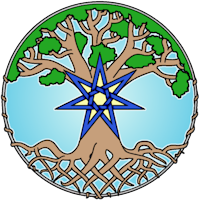Unfortunately, due to a sudden migraine, I missed the first workshop I had been intending to attend, Ellen Lorenzi-Prince’s “Inside-Out Magic.”
Working with the Celtic Tree Ogham in the United States, by Raven Edgewalker
This was a sort of follow-up to her presentation on Friday, where Raven went over working with the tree ogham in an experiential way, although both presentations would have been excellent as stand-alone workshops as well.
She began with listing off several ways one could work with the ogham outside of the UK, where all of the trees are native and available. First, she said you could simply work with it as an alphabet, linguistically, with poetry and the bardic arts. The ogham was never just trees, that’s just the most complete of the surviving symbol sets – perhaps because many of the ogham have tree names (although not all of them do). There seems to have also been a sow ogham and a bird ogham and perhaps many, many more. Secondly, she said, you could just work with the celtic tree ogham as-is, though in that case she recommends getting staves in the proper woods, so that you can have at least a small amount of the tree to work with. Her third point brought her to the topic at hand: creating your own version of the tree ogham, using trees local to your particular geographical location. She fielded a question from the attendees about a perhaps North-American-wide ogham, about including things from all across the US, and she said, sure, you could do that – but you’d have the same issues with not having a nearby tree to work with. So if you want to actually visit each tree in person, it’s a better idea to stick to trees that are no more than a day trip away, instead of including things like the Californian redwoods.
Starting from the presumption, then, that you want to create an ogham set based on local trees, Raven said there are still several different approaches. Some people try to find whatever tree is most closely biologically related to any missing trees, but she says that the meanings may be different, then. She gave an example of this: say you live in Florida, and the closest thing to a European Common Oak is the Live Oak. Now, the common oak is a deciduous, but the Live Oak is a hardwood evergreen. Those are very different trees with very different energies. Their magical and healing uses are probably very different, and that will change the meaning as a divinatory symbol. Instead, Raven recommends looking into the meaning of the missing tree in the divination system, learning what niche it occupies in the Celtic/British isles, and learning its magical and healing properties, and then finding a close substitute. For example, she says that Birch is the first letter of the ogham because in Britain where she lives, the birch is the first tree that re-colonizes cleared land, and it’s the first tree to bud leaves in the spring. So perhaps if you were trying to replace it, you should use whatever tree by you best occupies that ecological niche.
Next Raven gave us all a piece of silver birch bark, and had us really experience it for moment before describing it. Words used were shimmery, silvery, and it reminded some of the fae or the bardic arts. I found it to be rougher and stiffer than I expected, being more accustomed to paper birch, but others found it surprisingly soft. Then Raven led us on a brief journeyworking to meet the trees of the ogham – first the grove of the twenty Celtic trees, then our “own” ogham grove, where we might find trees different than those twenty. She had us interact with our “first” tree, Birch or its replacement. I had two – a Sugar Maple, and a Paper Birch. I suppose that makes Paper Birch my second tree, then!
Now that we had at least one tree and a place to start, she said it’s a good idea to go one tree at a time or one category of knowledge at a time as we learn about the trees and develop a personal relationship with them. She emphasized the importance of a personal relationship, because she believes that is what a lot of divination draws on: our own memories of and feelings for the trees. So perhaps your tree for new love won’t be the traditional Apple, but rather the Maple, because when you were a teen you and your boyfriend used to sit in the branches of a maple for hours together. And that is perfectly fine! The categories she mentioned are the following: learning to identify the tree by bark and leaves, learning what ecological niche it fills; learning what parts are edible or medicinal; learning what the wood is used for (like shipbuilding, furniture, etc); learning the role the tree plays in any folklore or mythology; and then doing journeyworkings to go and talk to the trees themselves and see what they have to say and what insights they offer.
I can’t wait to get started!
Closing Ritual
The Closing Ritual is always a bit low-key, and it’s hard sometimes to want to attend because everyone is so low energy and just wants to get home to sleep, but I find it provides important closure.
Gwendolyn Reece and Michael G. Smith thanked all spirits, especially Djehuty and Athena, for being with us and sharing in the hospitality. Then we sang a short chant and helpers moved around with small bowls of stones, offering one to each attendee as a parting gift. Then we ceded the space back to the mundane world, and the egregore of the conference was placed back into abeyance until the conference next year.
And that’s the whole conference! Thanks for reading!
~Réaltán~

[…] [Day 4] […]
[…] [Day 4 Here] […]
[…] [Day 4 Here] […]